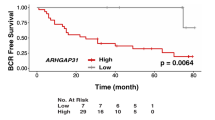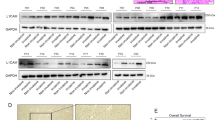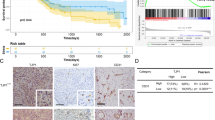Abstract
We demonstrate here that epithelial carcinoembryonic antigen (CEA)-related cell adhesion molecule-1 (CEACAM1) downregulation in prostate intraepithelial neoplasia (PIN) is inversely correlated with its upregulation in adjacent blood vessels. CEACAM1 silencing in prostate cancer cell line DU-145 via small interfering ribonucleic acid (siRNA) increased but its overexpression suppressed the expression of angiogenic/lymphangiogenic factors such as vascular endothelial growth factor (VEGF)-A, -C and -D, and angiogenic inhibitor collagen 18/endostatin. Furthermore, CEACAM1 overexpression in DU-145 cells increased but CEACAM1 silencing reduced angiopoietin-1 expression. Inverse relation was found for angiopoietin-2. Supernatant of CEACAM1-overexpressing DU-145 suppressed but that of CEACAM1-silenced increased the VEGF-induced endothelial tubes. Electron microscopically the majority of PIN-associated blood vessels was structurally destabilized exhibiting endothelial fenestration, trans- and inter-endothelial gaps. In some PIN areas, invasion of single tumor cells into the destabilized blood vessels was observed. These data show that disappearance of epithelial CEACAM1 in PIN is accompanied by its upregulation in adjacent vasculature which apparently correlates with vascular destabilization and increased vascularization of prostate cancer. Strategies to either conserve the epithelial CEACAM1 or to target endothelial CEACAM1 might be useful for an anti-angiogenic therapy of prostate cancer.
This is a preview of subscription content, access via your institution
Access options
Subscribe to this journal
Receive 50 print issues and online access
$259.00 per year
only $5.18 per issue
Buy this article
- Purchase on Springer Link
- Instant access to full article PDF
Prices may be subject to local taxes which are calculated during checkout







Similar content being viewed by others
References
Alitalo K, Carmeliet P . (2002). Cancer Cell 1: 219–227.
Bamberger AM, Riethdorf L, Nollau P, Naumann M, Erdmann I, Gotze J et al. (1998). Am J Pathol 152: 1401–1406.
Barnett TR, Drake L, Pickle W . (1993). Mol Cell Biol 13: 1273–1282.
Brummer J, Ebrahimnejad A, Flayeh R, Schumacher U, Loning T, Bamberger AM et al. (2001). Am J Pathol 159: 537–546.
Busch C, Hanssen TA, Wagener C, Obrink B . (2002). Hum Pathol 33: 290–298.
Cao R, Eriksson A, Kubo H, Alitalo K, Cao Y, Thyberg J . (2004). Circ Res 94: 664–670.
Carmeliet P . (2000). Nature Medicine 6: 389–395.
Chalajour F, Treede H, Ebrahimnejad A, Lauke H, Reichenspurner H, Ergun S . (2004). Exp Cell Res 298: 455–464.
Ebrahimnejad A, Flayeh R, Unteregger G, Wagener C, Brummer J . (2000). Exp Cell Res 260: 365–373.
Elbashir SM, Harborth J, Weber K, Tuschl T . (2002). Methods 26: 199–213.
Ergun S, Davidoff M, Holstein AF . (1996). Cell Tissue Res 286: 93–102.
Ergun S, Kilic N, Ziegeler G, Hansen A, Nollau P, Gotze J et al. (2000). Mol Cell 5: 311–320.
Hanahan D, Folkman J . (1996). Cell 86: 353–364.
Hixson DC, McEntire KD, Obrink B . (1985). Cancer Res 45: 3742–3749.
Hong YK, Foreman K, Shin JW, Hirakawa S, Curry CL, Sage DR et al. (2004). Nat Genet 36: 683–685.
Huss WJ, Hanrahan CF, Barrios RJ, Simons JW, Greenberg NM . (2001). Cancer Res 61: 2736–2743.
Iijima H, Neurath MF, Nagaishi T, Glickman JN, Nieuwenhuis EE, Nakajima A et al. (2004). J Exp Med 199: 471–482.
Izzi L, Turbide C, Houde C, Kunath T, Beauchemin N . (1999). Oncogene 18: 5563–5572.
Kilic N, Ergun S . (2001). Metastasis Research Protocols. Brooks SA and Schumacher U (eds). Humana Press: Oxford.
Kilic N, Oliveira-Ferrer L, Wurmbach JH, Loges S, Chalajour F, Vahid SN et al. (2005). J Biol Chem 280: 2361–2369.
Kuroki M, Arakawa F, Matsuo Y, Oikawa S, Nakazato H, Matsuoka Y . (1991). Biochem Biophys Res Commun 176: 578–585.
Lin SH, Culic O, Flanagan D, Hixson DC . (1991). Biochem J 278 (Part 1): 155–161.
Lin SH, Pu YS . (1999). Semin Oncol 26: 227–233.
Luo W, Tapolsky M, Earley K, Wood CG, Wilson DR, Logothetis CJ et al. (1999). Cancer Gene Ther 6: 313–321.
Mazzucchelli R, Montironi R, Santinelli A, Lucarini G, Pugnaloni A, Biagini G . (2000). Prostate 45: 72–79.
McDonald DM, Choyke PL . (2003). Nat Med 9: 713–725.
Neumaier M, Paululat S, Chan A, Matthaes P, Wagener C . (1993). Proc Natl Acad Sci USA 90: 10744–10748.
Nollau P, Prall F, Helmchen U, Wagener C, Neumaier M . (1997a). Am J Pathol 151: 521–530.
Nollau P, Scheller H, Kona-Horstmann M, Rohde S, Hagenmuller F, Wagener C et al. (1997b). Cancer Res 57: 2354–2357.
Oh P, Li Y, Yu J, Durr E, Krasinska KM, Carver LA et al. (2004). Nature 429: 629–635.
Oliveira-Ferrer L, Tilki D, Ziegeler G, Hauschild J, Loges S, Irmak S et al. (2004). Cancer Res 64: 8932–8938.
Poy MN, Yang Y, Rezaei K, Fernstrom MA, Lee AD, Kido Y et al. (2002). Nat Genet 30: 270–276.
Riethdorf L, Lisboa BW, Henkel U, Naumann M, Wagener C, Loning T . (1997). J Histochem Cytochem 45: 957–963.
Roberts WG, Palade GE . (1995). J Cell Sci 108 (Part 6): 2369–2379.
Rojas M, Fuks A, Stanners CP . (1990). Cell Growth Differ 1: 527–533.
Saaristo A, Veikkola T, Enholm B, Hytonen M, Arola J, Pajusola K et al. (2002). FASEB J 16: 1041–1049.
Singer BB, Scheffrahn I, Obrink B . (2000). Cancer Res 60: 1236–1244.
Volpert O, Luo W, Liu TJ, Estrera VT, Logothetis C, Lin SH . (2002). J Biol Chem 277: 35696–35702.
Wagener C, Ergun S . (2000). Exp Cell Res 261: 19–24.
Acknowledgements
We thank the ‘Deutsche Forschungsgemeinschaft’ for supporting this work. We are grateful to Professor C Wagener for his advice and for supporting us with the CEACAM1-specific antibody 4D1/C2. We also thank Mrs Sonja Gehlhaar for editing the English text.
Author information
Authors and Affiliations
Corresponding author
Additional information
Supplementary Information accompanies the paper on the Oncogene website (http://www.nature.com/onc).
Supplementary information
Rights and permissions
About this article
Cite this article
Tilki, D., Irmak, S., Oliveira-Ferrer, L. et al. CEA-related cell adhesion molecule-1 is involved in angiogenic switch in prostate cancer. Oncogene 25, 4965–4974 (2006). https://doi.org/10.1038/sj.onc.1209514
Received:
Revised:
Accepted:
Published:
Issue Date:
DOI: https://doi.org/10.1038/sj.onc.1209514
Keywords
This article is cited by
-
Anti-SSTR2 antibody-drug conjugate for neuroendocrine tumor therapy
Cancer Gene Therapy (2021)
-
The role of CEA-related cell adhesion molecule-1 (CEACAM1) in vascular homeostasis
Histochemistry and Cell Biology (2016)
-
Roles of CEACAM1 in cell communication and signaling of lung cancer and other diseases
Cancer and Metastasis Reviews (2015)
-
Clinical and experimental studies regarding the expression and diagnostic value of carcinoembryonic antigen-related cell adhesion molecule 1 in non-small-cell lung cancer
BMC Cancer (2013)
-
Carcinoembryonic antigen-related cell adhesion molecules (CEACAMs) in cancer progression and metastasis
Cancer and Metastasis Reviews (2013)



